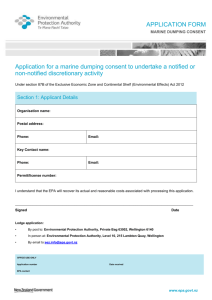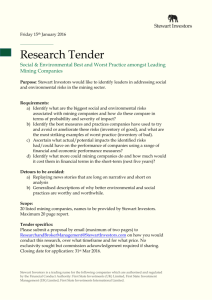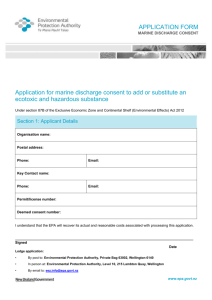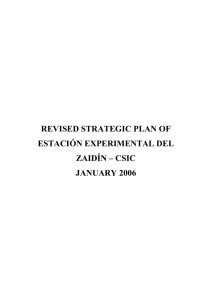Mining, environmental responsibility and social benefits
advertisement
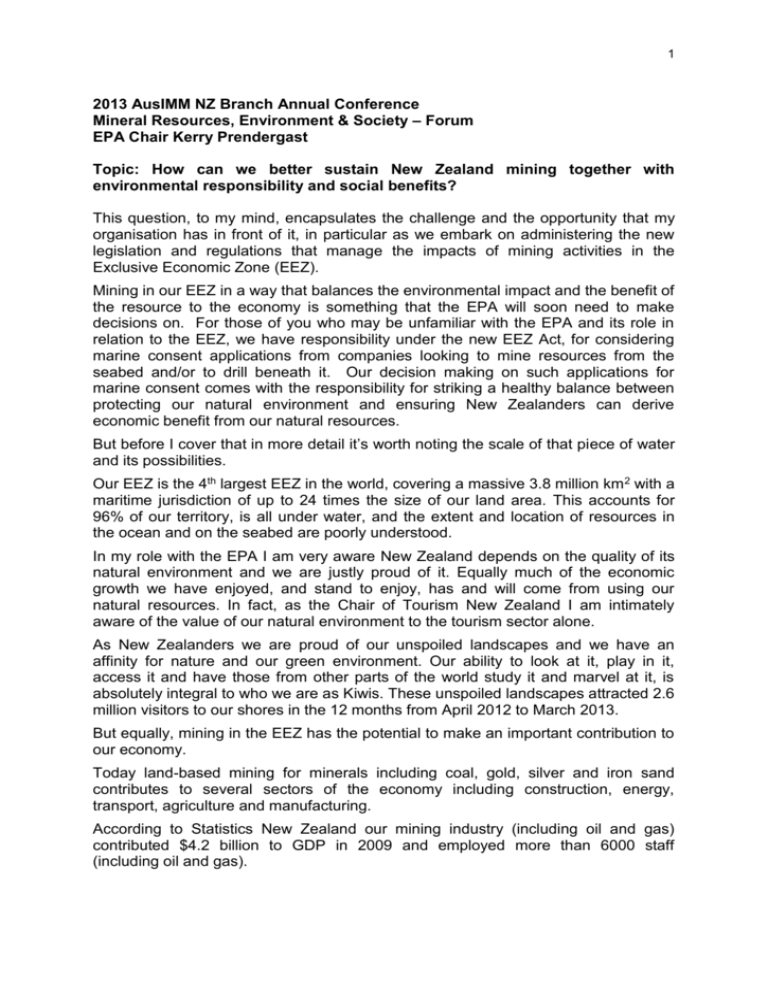
1 2013 AusIMM NZ Branch Annual Conference Mineral Resources, Environment & Society – Forum EPA Chair Kerry Prendergast Topic: How can we better sustain New Zealand mining together with environmental responsibility and social benefits? This question, to my mind, encapsulates the challenge and the opportunity that my organisation has in front of it, in particular as we embark on administering the new legislation and regulations that manage the impacts of mining activities in the Exclusive Economic Zone (EEZ). Mining in our EEZ in a way that balances the environmental impact and the benefit of the resource to the economy is something that the EPA will soon need to make decisions on. For those of you who may be unfamiliar with the EPA and its role in relation to the EEZ, we have responsibility under the new EEZ Act, for considering marine consent applications from companies looking to mine resources from the seabed and/or to drill beneath it. Our decision making on such applications for marine consent comes with the responsibility for striking a healthy balance between protecting our natural environment and ensuring New Zealanders can derive economic benefit from our natural resources. But before I cover that in more detail it’s worth noting the scale of that piece of water and its possibilities. Our EEZ is the 4th largest EEZ in the world, covering a massive 3.8 million km 2 with a maritime jurisdiction of up to 24 times the size of our land area. This accounts for 96% of our territory, is all under water, and the extent and location of resources in the ocean and on the seabed are poorly understood. In my role with the EPA I am very aware New Zealand depends on the quality of its natural environment and we are justly proud of it. Equally much of the economic growth we have enjoyed, and stand to enjoy, has and will come from using our natural resources. In fact, as the Chair of Tourism New Zealand I am intimately aware of the value of our natural environment to the tourism sector alone. As New Zealanders we are proud of our unspoiled landscapes and we have an affinity for nature and our green environment. Our ability to look at it, play in it, access it and have those from other parts of the world study it and marvel at it, is absolutely integral to who we are as Kiwis. These unspoiled landscapes attracted 2.6 million visitors to our shores in the 12 months from April 2012 to March 2013. But equally, mining in the EEZ has the potential to make an important contribution to our economy. Today land-based mining for minerals including coal, gold, silver and iron sand contributes to several sectors of the economy including construction, energy, transport, agriculture and manufacturing. According to Statistics New Zealand our mining industry (including oil and gas) contributed $4.2 billion to GDP in 2009 and employed more than 6000 staff (including oil and gas). 2 Mining provides us with economic opportunities and helps reduce our reliance on imported materials. Yet we need to remember that while mining will help build New Zealand’s economy and provide local jobs, we and certainly the EPA has a responsibility to ensure that those activities do not cause irreparable damage to the environment and leave a lasting legacy for future generations. We are all familiar with examples of mining that have not been sustainable such as the Tui mine which, even until recently, 35 years after its closure, it still threatened to pollute waterways with the heavy metals that were unearthed and left behind. The government committed $21.5 million to the clean-up and, together with money from the Waikato Regional Council and Matamata-Piako District Council, raised $22.5 million in total. The clean-up project lasted 5 years and was announced as complete earlier this year. Nevertheless, I do think that mining can be better sustained and we can have both the economic and social benefits it offers and a healthy and managed environment. I think the future of sustainable mining in the EEZ and on land rests largely in the possibilities offered by innovative new technologies and not in the mistakes of the past. I expect that those of you involved in industry here and globally, will lead the innovation that helps New Zealand derive social and economic benefit from mining while protecting the environment. And I believe that the continued development of sophisticated technologies will assist us in gaining the real value from our minerals sector. Innovative new technologies designed to minimise environmental impacts need to go hand in hand with our highly consultative regulatory regime to provide a level of comfort for all of us that in NZ we can better sustain mining together with environmental responsibility and social benefits. And so to the work that my organisation does in this area in the quest to achieve this balance of “better” sustaining mining together with environmental responsibility and social and economic benefits. The EEZ Act and regulations contain criteria that we must use to reach decisions that reflect a healthy balance. This means we will have to consider the environmental effects of mining the seabed and take into account the economic and social benefits. To get our decisions to the best possible outcomes our role is in a very real sense as a facilitator of dialogue between parties whose business is mining in the EEZ, those who have interests in the EEZ, and those opposed to mining there altogether. When we at the EPA have talked to those who have and will make applications for consents to mine and to drill in the EEZ, we have emphasised the importance of talking and listening. We urge applicants to come to us before lodging applications – to talk informally with us about their intentions, the potential impacts on the environment and about those with existing interests in the areas affected such as Iwi, the fishing and shipping industries and recreational groups. 3 We urge them to do as much as they can to talk with those with interests, to show evidence of understanding the implications of their proposed activity and to draw well supported conclusions. We emphasise this engagement so that when business people such as many of you here today lodge an application, we can move efficiently on with the rest of the process – that is to public notification, consideration of submissions and making decisions. In consent applications, we ask operators to assess the impacts of their proposed activity. These assessments are an integral part of the application and approval process and must tell us about who is behind the proposal, the nature of the project and its objectives, where it is to happen, the type of natural environment there, and the likely impacts on that environment and on those with existing interests in that area. Operators also need to provide information about how they aim to avoid, remedy or mitigate adverse effects. All of this means a comprehensive and detailed assessment of the environment before development commences including useful data on the nature and characteristics of that area. In many cases it will have meant looking at previously unidentified or poorly studied environments. One of the key things about the EEZ for example is that we know very little about a great deal of it – either from an environmental perspective, or in terms of the mineral resources it contains. NZ’s marine environment is particularly rich and complex due to its extension over 30 degrees latitude (from sub-tropical to sub-Antarctic). Our position in relation to major water-masses and current systems also contributes to our unique environment. According to DOC, we may have as many as 65,000 species in NZ waters and our isolation mean that many of these species may not be found elsewhere. Currently, just 1 percent of NZ’s marine environment has ever been surveyed. So exploration for minerals and resources has the potential to identify sensitive environments which must be conserved (DOC source). And undeniably those discoveries will challenge industry but nonetheless it is a potentially positive result of the new regime. Over time, the applications and consent process, as well as the operations that take place in the EEZ, will offer opportunities to learn a great deal more about the marine environment than we currently know. And the reality is that without industry wanting to push into that frontier the area would remain undiscovered. I certainly believe that the EPA’s role and the processes it runs have the potential to improve the balance between mining impacts and social and economic benefits. Our process is all about transparency and working together to make sure that things are done in the best possible way. Sharing publicly, the documentation that the consent applications process requires – mainly through the EPA website – is a key demonstration of our commitment to 4 ensuring access all of the important information for all of the people interested and involved. In an important sense it imposes a measure of accountability on all involved in the process so that we can all understand perspectives and views constructively expressed, and see the evidence presented to support differing positions. The EPA is well versed in managing and deciding issues related to environmental effects and risk through our RMA and HSNO functions and we are looking to bring the best of our experience to our EEZ function. But we know that we will face challenges with managing public expectations in respect of the decisions we might make. We believe an open and transparent process will be beneficial to all. An inquisitional hearing process will maximise opportunities for public input. For instance, the public will have the opportunity to have their concerns heard directly by the Decision Makers and to test the information presented by an applicant in their consent application. However, an applicant will also have the advantage of addressing these concerns raised by the public with expert evidence and testimony. That’s what our applications process is set up to do and I believe that with the willing cooperation and constructive participation of all parties, we can succeed. This is not to suggest that I think we will be popular as a government agency. Our position and our role necessarily means that often times we will be disliked equally on both sides of a given issue. Such is the lot of those required to try and make balanced decisions that affect those on both sides of controversial issues – especially seabed mining. The EPA does of course have powers to monitor operations to make sure that any conditions we might attach to consents are adhered to. This is a new area for the EPA and we are looking carefully at how we exercise those powers. The key to our credibility and therefore to the credibility of our decisions is that we are perceived as an organisation with both the expertise and the integrity to maintain a healthy balance between protecting the environment and ensuring New Zealanders can derive economic benefit from this country’s natural resources. Understanding the nature and implications of Maori interests affected by mining proposals is particularly important and the EPA has an extensive resource in-house to assist operators in properly satisfying those requirements. Our credibility also depends on having processes that are both efficient and manageable for business interests, but that afford interested parties every opportunity to have information and to participate in discussion and debate about proposals to mine. We are making every effort to achieve that and will certainly improve and enhance as we go. Of course we are always open to suggestions from all interested parties about improvements. So to conclude, at the EPA we answer an unequivocal yes to the question posed. We believe that the regime applied to the EEZ and to mining there will lead to better more sustainable environmental practice around operations that can bring economic 5 benefit to New Zealand. That said we are yet to decide an application so watch this space. Together with yourselves and many other concerned and interested parties, we are at the beginning of a potentially exciting new era. Thanks so much for your time and I look forward to talking with you and listening to your thoughts.



